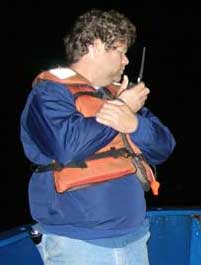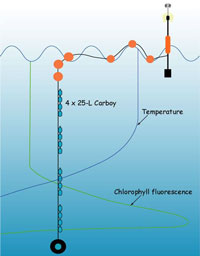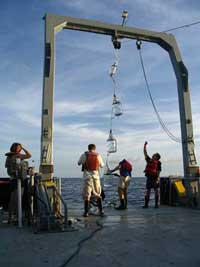


|
The Project Part 1: Part 2: Part 3:
| Daily JournalFebruary 2, 2005:
|
Sunshine monitors the goings-on and tells the captain
A schematic of what an array looks like in the water, though not an exact representation of our array
This picture, taken last July, shows what it takes to get the array in the water. I’m on the left, working that huge metal frame, Terri’s out of site letting the line in and out. Brian’s signaling Terri to let the line in little by little. |
Today we sent off the second array. An array is a long line of rope with a 100-pound weight at the bottom and round, orange floats at the top. The weight at the bottom makes sure the line stays up and down, and at the top there’s a special float with a bright, flashing light that sends out a radio signal. It’s 150 meters from top to bottom, with various things attached in between, so that they’ll float around at a specific point in the water column.
On our array, we attached a set of sediment traps at 100 meters' depth, which will collect any particle that floats down from the surface and into the trap. We also attached a number of plastic carboys (containers), which were placed at 30 meters’ depth and above. The idea is that as you go deeper in the ocean, there’s less and less light until there’s no light at all. So at the surface there’s a lot of light, but by the time you get to 30 meters, there’s much less and the light is dim. (What affect do you think this has on ocean life?) The water in the carboys was collected by using the CTD, so it’s actual ocean water, but with a special chemical added so we can measure how fast the plants in the water grow. By placing this special water at different depths, we can see how the speed at which plants grow is affected by different amounts of light.
This is a pretty cool experiment, but it takes lots of people to send off, or deploy, the array. Fred, Richard, and Brian work at attaching all the bottles and the sediment trap. Terri works the winch which lets the array line up and down, I work the A-frame which lets the line in and out, and Eduardo and Ramses help in fetching needed items. The ship’s crew help out a lot, too, by making sure the ship is where it needs to be. Steve (called Sunshine), an A/B on board, monitors the line as it’s let out and tells the Captain who’s in the bridge (and can’t see) what’s going on. Rob, our technician, supervises and makes sure everything’s going smoothly. And of course, there’s Captain Manion, who steers and watches the water conditions.
Q: If you look at the picture of all of us below, you can see Brian giving hand signals to Terri at the winch. Hand signals become necessary when you can’t hear and need to communicate. What are some other instances where this type of communication becomes important?
![]()




